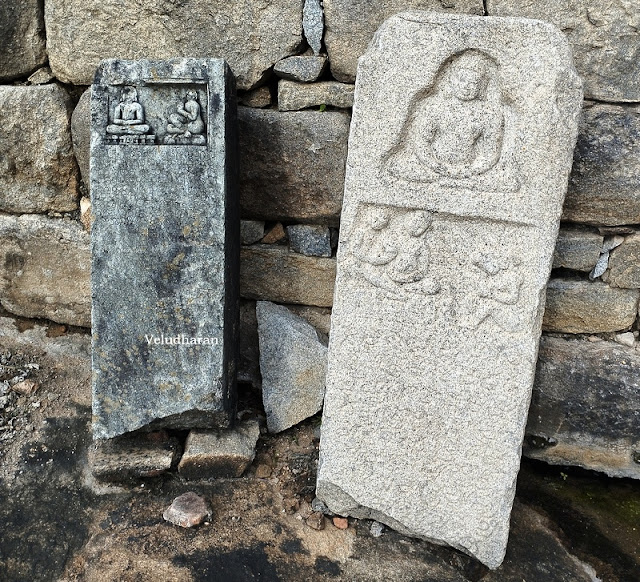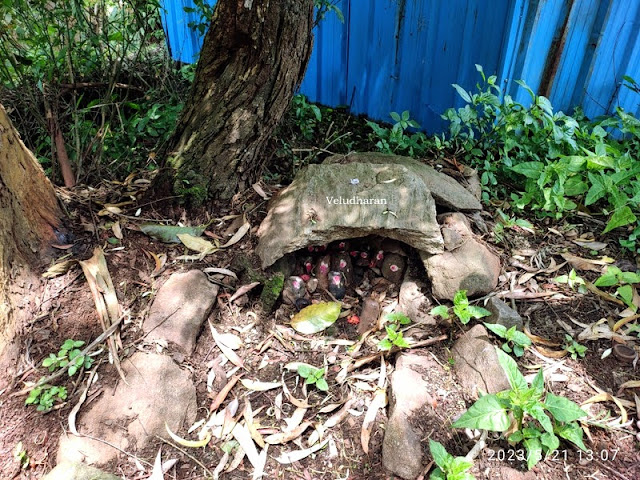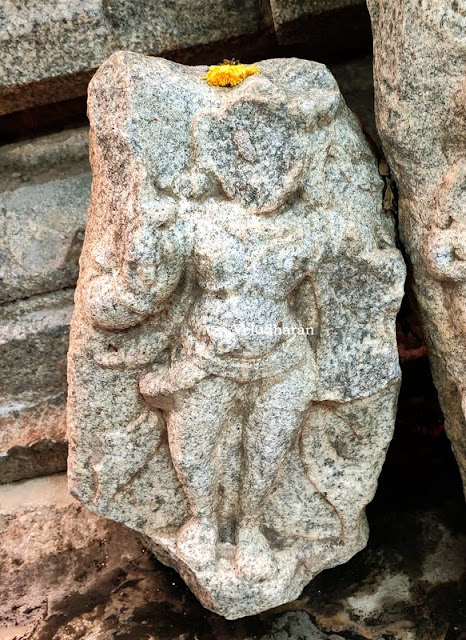After the Visit to Sri Mahakaleshwarar
temple at Palayanoor near Padalam, Chengalpattu, Mr Sriram, told me about this
Kozhikal at Indalur near Acharapakkam. Decided to see this historically important Kozhikal, which rarely available.
This Kozhikal is on the right side of
the entrance to the Sri Sengazhuneer Vinayagar Temple at Indalur near
Acharapakkam in Chengalpattu District. This Kozhikal has the image of a cock
facing south with two line inscription with the mixture
of Tamizhi and vattezhuthu. As per the experts, this inscription belongs to 6th
to 7th Century ie the transition period of Tamizhi to vattezhuthu.
The Kozhikal measures to a height of 68 cm and width by 61 cm.
This Kozhikal was identified by one
Thamaraikannan of Acharappakkam and read by Sri Natana Kasinathan and Iravatham
Mahadevan. The inscription details and the meanings of all the three are not
matching with others. All the three published their findings in different
forums. As per Sa Krishnamurthy, of these Sri Iravatham Mahadevan’s article may
be correct.
The inscription may be read as –
Keezhaicheri kozhi PoRkoRRi - கீழைச்சேரிக் கோழி
பொற்கொற்றி. Which means that this kazhikal was
erected for a Cock named KoRRi, which might have died during cock fight.
The article of the book is
reproduced, which is given below.
இந்தளூர் ஸ்ரீ
செங்கழுநீர் வினாயகர் கோயில் நுழைவாயில் வலப்புறம் தெருவோரமாகக் கோழிக்கு எடுத்த
நடு கல்லை அச்சிறுப்பாக்கம் தாமரைக்கண்ணன் கண்டறிந்தார். நடன. காசிநாதன், ஐராவதம்
மகாதேவன் ஆகிய அறிஞர்கள் இந்தளூர் கோழிக்கல் குறித்துஆய்வுக்கட்டுரைகள்
எழுதியுள்ளார்கள். இருவர் வாசிப்பிலும் வேறுபாடுண்டு. பொருள் கொள்ளும் முறையிலும்
மாறுபாடுண்டு. தாமரைக்கண்ணன் பொருள் கொண்ட முறையிலும் வித்தியாசமுண்டு. இந்த
நடுகல் பலகையின் உயரம் 68 செ.மீ. அகலம் 61 செமீ கல்லில் இருவரி வட்டெழுத்து
கல்வெட்டும் கம்பீரமான தோற்றத்துடன் சேவல் புடைப்புச் சிற்பமும் உள்ளன. நடன. காசி
நாதனும் தாமரைக்கண்ணனும் பின்கண்டவாறு வாசித்துள்ளனர்.
- கீழுச்சேரிக் கோழி பொ
- டு கொத்த
நடன. காசிநாதன் இதற்குப் பொருள் கூறும்போது தானியங் களைக் கொத்தித் தின்னும் கோழி
என்று குறிப்பிட்டார். தாமரைக்கண்ணன் ஒரு கட்டுரையில் ( தமிழ் நாட்டுவரலாற்றுக்
கருத்தரங்கு த.தொ.ஆ.துறை-1976) கீழச்சேரிக்கோழி பகைக் கோழியைப் பொட்டலாகப்
போகுமாறு அதாவது சிறகுகள் எல்லாம் சிதைந்து போகுமாறு கொத்தி வீரப் போர் புரிந்தது
என்று கூறியுள்ளார். இருவரும் கல்வெட்டின் காலம் கி.பி. ஏழாம் நூற்றாண்டு என்று
குறிப்பிட்டனர்.
கல்வெட்டறிஞர் ஐராவதம்
மகாதேவன் பல முறை நேரில் சென்று ஆய்ந்து கல்வெட்டைப் பொருத்தமாக அதாவது
திருத்தமுறப் படித்து ஆவணம் இதழிலும் தம்முடைய தமிழ் பிராமி கல்வெட்டுகள் என்ற
ஆங்கில நூலிலும் பதிப்பித்துள்ளார்கள். பலரும் ஏற்றுக்கொள்ளும்படியான விளக்கத்தையும் எழுதியுள்ளார்கள்.
- கிழச்செரிக் கொழி பொ
- ற கொற்றி
இதனைக் கீழ்ச்சேரிக் கோழி பொற்கொற்றி என்று வாசிக்கவேண்டும் என்று
குறிப்பிட்டுள்ளார்கள். முதல்வரியல் 'க்' மற்றும் 'ச்' எழுத்துகளுக்குத் தெளிவாகப்
புள்ளிகள் உள்ளன. ஆனால் இரண்டாம் வரியில் றகர மெய் எழுத்துகள் இரண்டிற்கும் புள்ளி
இல்லை. முதல் வரியில் வரும் இரண்டாவது எழுத்தை நடன. காசிநாதன் ழு என்ற
வாசித்துள்ளார் ழ கரத்தின் வலப்புற முள்ள கோட்டினை உகரமாகக் கொண்டுள்ளார். ழி என்ற
எட்டாவது எழுத்திலும் கோடு வருவதை விட்டுவிட்டார். எனவே ஐராவதம் படித்த 'ழ' பாடமே
ஏற்புடையதாகும். கீழ்ச்சேரி அல்லது கீழைச்சேரிக் கோழி பொற்கொற்றி என்று வாசித்துப்
பொருள் கொள்ளலாம்.
இகர ஈகார உயிர்மெய்க் குறியீடுகளில் வேற்றுமை இல்லை. முதல் வரியில் வரும் கோ
எழுத்தின் உயிர் மெய் தமிழி எழுத்தமைப்பிலும் இரண்டாவது வரியில் வரும் கொ எழுத்து
வட்டெழுத்து முறையிலும் உள்ளன. இவ்விரு எழுத்து முறைகள் தமிழ் வட்டெழுத்தாக மாறும்
காலக்கட்டம் எனலாம்.
ஊகங்கள்
கீழைச்சேரி ஓர்
ஊராகும். இந்தளூரின் பழைய ஊர்ப் பெயராக இருந்திருக்கலாம். இனி இந்தளூருக்கு
வடகிழக்கில் 15 கி.மீ. தூரத்தில் செய்யூருக்கருகில் தற்போதுள்ள கீழைச்சேரியாகவும்
இருக்கலாம். வல்லவரையன் மனைவி இந்தளாதேவியின் பெயரால் இந்தளூர் ஏற்பட்டிருக்க
வேண்டும். பொற்கொற்றி என்பது கோழியின் செல்லப்பெயர். கொற்றி என்ற சொல் பழங்குடி
திராவிட மொழிகளில் கோழி, சேவல் என்று பொருளாகும். நடுகல்லான நாய்க்குக் கோபாலன்
என்ற பெயர் இருப்பது போல் புனிஷா என்ற பெயர் இருப்பது போல் பொற்றி
இருந்திருக்கலாம். பொன் கொற்றி பொற்கொற்றியாகும். கொற்றி என்ற சொல்லை நன்னூல்
உரையாசிரியர் எடுத்தாண்டுள்ளார். கொற்றி என்பது கொற்றவைக்கு ஒருபெயர். பெயர்களைக் குறிப்பிடும்போது
பொன் என்றசொல் செல்வமாகும். பொன் என்ற அடையுடன் பலருடய பெயர்களை நடுகற்களில்
காண்கிறோம். இங்கே பொன் என்ற சொல் கோழிக்கு அடையாக வந்துள்ளது.
துணை நூல்:
நடுகற்கள்-ச.கிருஷ்ணமூர்த்தி
LOCATION OF THE KOZHIKAL : CLICK HERE












































